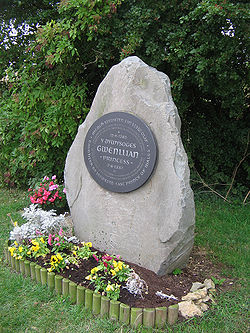Gwenllian of Wales
| Gwenllian of Wales | |
|---|---|
| Born | June 1282 Lincolnshire, England |
| House | Aberffraw |
| Father | Llywelyn ap Gruffudd |
| Mother | Eleanor de Montfort |
Gwenllian of Wales or Gwenllian ferch Llywelyn (June 1282 – 7 June 1337) was the daughter of
Lineage
Gwenllian (pronounced
Capture by King Edward I
A few months after Gwenllian's birth, northern Wales was encircled by the English army of
Confinement
Gwenllian and the daughters of her uncle Dafydd ap Gruffudd were all confined for life in remote priories in
Gwenllian's royal rank was acknowledged at least once by the English Crown. When writing to the Pope, attempting to secure more money for Sempringham Priory from the Church, the English king stated that "...herein is kept the Princess of Wales, whom we have to maintain". The title "Princess of Wales" as used here did not have its usual accepted meaning.[7]
Having been taken from her native land so young, Gwenllian is unlikely to have remembered any Welsh she may have learned as a toddler, and perhaps never knew the correct pronunciation of her own name. The priory record-keepers listed her as "Wencilian" and was herself shown to have signed her name "Wentliane".[8]
Old age and death


Edward III of England, Edward I's grandson, endowed Gwenllian with a pension of £20 per year; this was not money for her personally, simply a sum paid on her behalf to the priory in respect of her food and clothing. Her death there was recorded by the priory's chronicler in June 1337, a few days before her 55th birthday.[9]
Fate of her male cousins
Dafydd's two young sons, heirs to the Principality or Kingdom of Wales, were taken to Bristol Castle, where they were held prisoner; Llywelyn ap Dafydd died there in 1287, four years after his capture, and was buried in the Dominican Church. Owain ap Dafydd survived his brother. The date of his death is unknown, but it was after 1305, when the King of England ordered a cage made of timber, bound with iron, in which to hold Owain ap Dafydd more securely at night.[10]
Edward I took the title of "Prince of Wales" for the Crown, bestowing it upon his son, Edward, at a Parliament held in Lincoln in 1301 at the age of seventeen. The title is still given to the heir apparent to the British crown to this day.
Gwenllian in later culture
- A memorial (pictured at right) made of Welsh granite was erected near Saint Andrew's Church, Sempringham, known to locals as Sempringham Abbey, in Lincolnshire. There is also a display about Gwenllian inside the church, although visitors must request the key to enter and view it.[11]
- Gwenllian has been commemorated at least twice in poetry. "Gwenllian", by Bardic Chair at the National Eisteddfod, Wales' top honour for poetry.
- On 26 September 2009, Carnedd Uchaf, in the Carneddau mountain range in Snowdonia, was formally renamed Carnedd Gwenllian in her memory following a lengthy campaign by the Princess Gwenllian Society.[12] The Ordnance Survey added the names Carnedd Uchaf / Carnedd Gwenllian on its maps to be published from 2010 onwards.[13]The original name of Garnedd Uchaf, which is within the Bounds of Abergwyngregyn, is Garnedd Lladron.
- A plaque has also been placed on a rock just below the summit of Snowdon commemorating "the Princess Gwenllian (1282-1337), only child of Prince Llewelyn ap Gruffudd, Lord of Snowdonia, Prince of Wales."[14]
Ancestry
| Ancestors of Gwenllian of Wales | ||||||||||||||||||||||||||||||||||||||||||||||||||||||||||||||||||||||||||||||||||||||||||||||||||||||||||||||||||||||||||||||||||||||||||||||||||||||||||||||||||||||||||||
|---|---|---|---|---|---|---|---|---|---|---|---|---|---|---|---|---|---|---|---|---|---|---|---|---|---|---|---|---|---|---|---|---|---|---|---|---|---|---|---|---|---|---|---|---|---|---|---|---|---|---|---|---|---|---|---|---|---|---|---|---|---|---|---|---|---|---|---|---|---|---|---|---|---|---|---|---|---|---|---|---|---|---|---|---|---|---|---|---|---|---|---|---|---|---|---|---|---|---|---|---|---|---|---|---|---|---|---|---|---|---|---|---|---|---|---|---|---|---|---|---|---|---|---|---|---|---|---|---|---|---|---|---|---|---|---|---|---|---|---|---|---|---|---|---|---|---|---|---|---|---|---|---|---|---|---|---|---|---|---|---|---|---|---|---|---|---|---|---|---|---|---|---|
| ||||||||||||||||||||||||||||||||||||||||||||||||||||||||||||||||||||||||||||||||||||||||||||||||||||||||||||||||||||||||||||||||||||||||||||||||||||||||||||||||||||||||||||
Primary source references
- Calendar of Patent Rolls, 1281–92, 321 (Inquiry of 1289 concerning the custody of the Welsh royal children)
- Calendar of Papal Letters, ii, 185, 273
- Calendar of Memoranda Rolls, 1226–7, no. 2160
- Calendar of Close Rolls, 1327–30, 65, 175, 273, 322, 438
- Public Record Office, London E101/351/9 (Letter, noting provision made for the needs of the Welsh royal children, 11 November 1283)
- Calendar Ancient Petitions, 458 (letter from Gwenllian)
- Robert Manning (a canon at Sempringham then at Sixhills) see The Works of Thomas Hearne, 4 vols (London, 1810)
- Annales Prioratus de Dunstaplia, 293-4
- Accounts of Bristol Castle
References
- ^ The Golden Grove 1641 Pedigree - Carmarthenshire County Archive.
- ^ Dwnn, L. 'The Heraldic Visitation of Wales', Vol II, 1846, p. 24.
- ^ "The Royal Families of England, Scotland, and Wales, with Pedigrees of Royal Descents in Illustration" (PDF). Sir Bernard Burke, C.B., LL.D., Ulster King of Arms. 1876. p. 51.
- ^ Owen, Edward: ‘Owain Lawgoch – Yeuain de Galles: Some Facts and Suggestions’, The Transactions of the Honourable Society of Cymmrodorion, p. 16, Session 1899-1900
- ^ ISBN 978-1-78316-007-5.
- ISBN 9780955299599.
- ISBN 9780708319369.
- ^ Gwenllian, Princess of Wales at castlewales.com
- ^ Frederick Maurice Powicke, King Henry III and the Lord Edward: the community of the realm in the thirteenth century, vol. 2 (The Clarendon Press, 1947), p. 684
- ^ Accounts of Bristol Castle, xxx, xxxii–iii, 17, 26–7, 46, 66, 90, 91
- ^ "The Princess Gwenllian Society - Cymdeithas y Dywysoges Gwenllian". Retrieved 14 September 2016.
- ^ "BBC NEWS - UK - Wales - North West Wales - Bid to rename peak after princess". Retrieved 14 September 2016.
- ^ "The Princess Gwenllian Society - Cymdeithas y Dywysoges Gwenllian". Retrieved 14 September 2016.
- ^ "The Princess Gwenllian Society - Cymdeithas y Dywysoges Gwenllian". Retrieved 14 September 2016.
External links
- The Princess Gwenllian Society is responsible for many of the above-mentioned memorials to Gwenllian, and continues working to keep her memory alive as a matter of Welsh national pride. (Their website may be read either in English or Welsh.)
- Castles of Wales has a page dedicated to Gwenllian, including photographs of her own memorial and that of her father.
